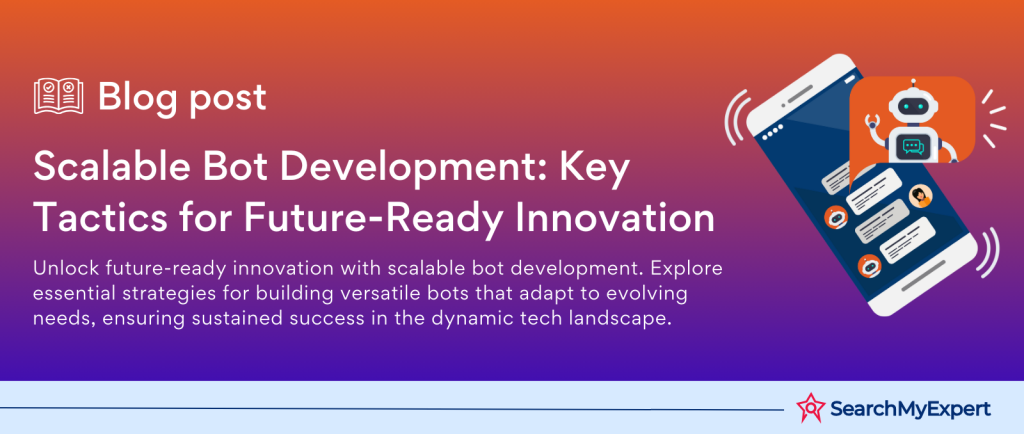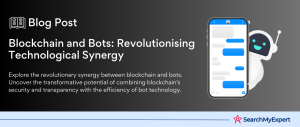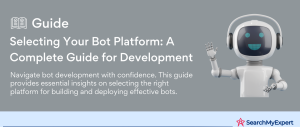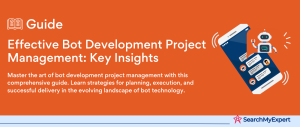Scalability in Bot Development
Bots: A Brief Overview
Bots, digital assistants programmed to perform various tasks, have revolutionized interaction in the digital realm. They’re software applications driven by algorithms, evolving from simple automated tasks to complex, AI-powered systems. Their applications range from customer service chatbots, social media automatons, to sophisticated data analysis tools.
The Importance of Scalability
Scalability, the capability to handle growth, is a cornerstone in bot development. It’s not just about handling more users but managing increased complexity and evolving functionalities. In an era of exponential digital growth, scalability ensures that bots can adapt and expand without compromising performance or user experience.
Challenges in Scalable Bot Development
Building scalable bots comes with its hurdles. As user volume spikes, bots must maintain efficiency and accuracy. They must evolve, learn from interactions, and adapt to diverse user behaviors and languages. The architecture must support this growth, balancing robustness with agility. Security and privacy concerns amplify as bots handle more data. Navigating these challenges is vital for successful bot deployment.
Understanding User Growth in Bot Development
Analyzing User Growth Patterns
- Linear Growth:
Linear growth in user numbers is steady and predictable. Bots experiencing this pattern can be scaled methodically, allowing developers to make incremental improvements. - Exponential Growth:
Unlike linear growth, exponential spikes are rapid and can overwhelm unprepared systems. Bots must be designed with flexible architectures to quickly adapt to this surge without performance degradation. - Seasonal Fluctuations: Some bots face seasonal or event-driven spikes in usage. Their scalability needs to be dynamic, able to ramp up for high demand periods and scale down during quieter times.
Metrics for Measuring Engagement and Performance
- User Engagement Metrics:
Key indicators include session length, interaction rates, and user satisfaction scores. They reflect how effectively the bot engages users. - Performance Metrics at Scale: Response time, error rate, and throughput are crucial. These metrics indicate the bot’s ability to handle high volumes without compromising quality.
Scalability: Chatbots vs. Conversational AI
- Simple Chatbots: These bots, often rule-based, are easier to scale as they follow predetermined paths and responses.
- Complex Conversational AI:
These systems, powered by machine learning, require more sophisticated scaling strategies. They must process and learn from vast datasets, demanding more resources as they grow.
Architectural Principles for Scalability in Bot Development
Embracing Microservices Architecture
- Microservices Architecture:
A paradigm shift from monolithic designs. Microservices architecture involves developing small, independently deployable services. Each service focuses on a specific function, facilitating better scalability and easier updates. - Benefits for Distributed Bot Development:
This approach allows bots to be more resilient and flexible. Services can be scaled individually based on demand, enhancing overall system performance and reducing downtime.
API Integration and Event-Driven Communication
- Efficient Information Flow:
APIs (Application Programming Interfaces) are vital for integrating different microservices. They allow separate services to communicate seamlessly, sharing data and functionalities. - Event-Driven Communication: This model allows services to react to real-time events. In bot development, this means quicker responses to user interactions, making the bot more dynamic and engaging.
Database Management for Large Data Volumes
- Database Selection:
The choice of database technology (SQL or NoSQL) can impact scalability. Factors like data structure, query complexity, and transaction frequency guide this decision. - Partitioning Strategies: Database partitioning is crucial for handling large data volumes. It involves dividing the database into smaller, manageable parts, ensuring quicker access and better performance.
Building Scalable Bot Components
Scaling Natural Language Processing (NLP) Components
- NLP Scalability Considerations:
NLP, the core of understanding user inputs, faces unique scaling challenges. As user interactions increase, the NLP component must effectively process diverse languages and dialects while maintaining quick response times. - Optimization Techniques:
Implementing machine learning models that can learn and adapt with less data helps. Also, using cloud-based NLP services can offer scalability and performance benefits.
Optimizing Dialogue Management Systems
- Handling Increased User Load: Dialogue management, which dictates the bot’s responses, must remain efficient under heavy user traffic. It requires balancing pre-defined rules with AI-driven conversation flows.
- Techniques for Optimization:
Employing state management to track conversations and applying load balancing techniques ensures smooth operation. Utilizing caching for frequently used dialogues can significantly reduce response time.
Strategies for Scaling Chatbot Interfaces
- Adapting Delivery Channels:
Bots must function seamlessly across various platforms—web, mobile, messaging apps. This demands a flexible interface design that can adapt to different screen sizes and interaction patterns. - Scaling Strategies:
Using responsive design principles and platform-agnostic development frameworks ensures that the bot’s interface scales efficiently. Regular updates and testing across all platforms are essential for maintaining performance.
Monitoring and Performance Optimization in Bot Development
Implementing Key Performance Indicators (KPIs)
- Continuous Performance Monitoring: KPIs are critical for assessing a bot’s efficiency and effectiveness. Common indicators include response time, error rate, user satisfaction, and conversation completion rates.
- Benefits of KPIs:
They provide real-time insights into bot performance, helping identify areas needing improvement. This data-driven approach ensures that bots remain effective and user-centric.
Load and Stress Testing Methodologies
- Identifying Bottlenecks:
Load testing simulates normal usage conditions, while stress testing pushes the bot to its limits. These tests are essential to understand how the bot behaves under different levels of demand. - Methodology:
By incrementally increasing the number of user requests, developers can pinpoint when and why performance issues occur. This information is crucial for making targeted improvements.
Leveraging Automation for Scaling and Resource Management
- Proactive Scaling:
Automation tools can dynamically allocate resources based on current demand, ensuring the bot remains responsive and efficient. - Resource Management:
These tools monitor resource usage, predict future demands, and make adjustments accordingly. This proactive approach minimizes downtime and optimizes resource utilization.
Continuous Integration and Deployment (CI/CD) for Scalability in Bot Development
CI/CD Practices
- Fast and Reliable Development: Continuous Integration (CI) and Continuous Deployment (CD) form a cornerstone for agile and scalable bot development. CI/CD streamlines the development process, allowing for faster, more reliable updates and deployments.
- Benefits:
These practices reduce the chances of integration issues, ensuring that bot updates are less disruptive and more consistent. They foster a culture of continuous improvement, vital for scalable bot ecosystems.
Automation in Testing, Packaging, and Deployment
- Streamlined Processes:
Automation is key in CI/CD, handling tasks like testing, packaging, and deployment of bot updates. It ensures consistency and speed, reducing human error. - Efficient Updates: Automated testing validates new features and identifies bugs before deployment. Automated packaging and deployment mean updates are rolled out quickly and smoothly, maintaining bot performance and reliability.
Infrastructure Automation for Cloud Resources
- Managing Resources Efficiently: Infrastructure automation is critical for managing cloud-based bot resources. It enables scalable, flexible resource allocation in response to fluctuating demands.
- Significance:
This approach allows for the efficient use of cloud resources, reducing costs and improving performance. It supports the scalability of bots by ensuring they have the necessary resources in a dynamically changing environment.
Future Trends and Considerations in Scalable Bot Development
Embracing Emerging Technologies
- Serverless Computing:
A paradigm shift in computing, serverless architecture allows developers to build and run applications without managing servers. It’s ideal for bots, offering scalability and cost-effectiveness, as resources are used only when needed. - Edge Computing:
By processing data closer to the source, edge computing reduces latency. For bots, this means faster response times and reduced reliance on central data centers, enhancing scalability, especially for IoT applications.
AI-Driven Self-Optimization and Automated Scaling
- The Potential of AI:
Artificial Intelligence is revolutionizing bot scalability. AI can enable bots to self-optimize by learning from user interactions and automatically scaling resources based on demand. - Automated Scaling:
AI algorithms can predict load spikes and adjust resources in real-time. This ensures bots remain efficient and responsive under varying load conditions, a critical aspect of scalability.
Continuous Learning and Adaptation: Keys to Long-Term Scalability
- Importance of Adaptation: The digital landscape is constantly evolving. Bots must continuously learn from new data, user behaviors, and evolving technologies to stay relevant and effective.
- Long-Term Scalability:
Continuous learning and adaptation are not just about handling more users; they’re about evolving with the changing digital ecosystem. This approach ensures bots remain useful, engaging, and scalable in the long run.
Conclusion
Scalability is the cornerstone of modern bot technology, demanding a multifaceted and adaptive approach. Integrating microservices architecture, utilising AI for real-time optimization, and adopting innovative technologies like serverless and edge computing are crucial. As we navigate this evolving landscape, the key lies in our ability to continually adapt and innovate. Scalable bots are essential in our increasingly complex digital world, not just matching its pace but driving technological advancements forward. They represent a future where efficiency, responsiveness, and innovation are paramount in our interactions with technology.
Maximize your digital capabilities with our Bot Development Service Services.
Table of Contents
Toggle






